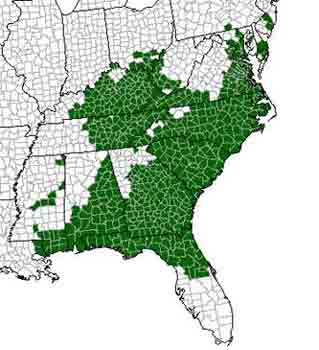
Midland Mud Salamander
(Pseudotriton montanus diastictus)
 |
 |
|
|
Distribution of the Mud Salamander (from the AR MI Atlas)
|
An adult Midland Mud Salamander.
|
|
Description: One of the most striking Ohio salamanders, the Midland Mud Salamander could only be confused with the Northern Red Salamander. It differs in having fewer black spots, a ground color that is more orange than red (although this is subject to a great deal of individual variation), and eyes that are colored brown. The stout body and short tail are characteristic of the genus. |
||
Distribution in Ohio: Records exist from only 8 southeastern Ohio counties. |
||
|
|
||
Status in Ohio: The Ohio Division of Wildlife lists the Midland Mud Salamander as THREATENED. |
||
|
|
||
Habitat: Found in springs, seeps, and creeks. Much of the life of this animal is probably spent underground in burrows, making sightings of this species rare. |
||
|
|
||
Life history: The mud salamander is rarely found far from water or muddy seeps. Its eggs have never been observed in Ohio, but they are believed to be attached to roots and rocks underground in springs and seeps during the winter. After hatching, the aquatic larvae may take 3-4 years before completing metamorphosis. An additional year or two is required before reaching sexual maturity. |
||
|
|
||
Conservation: Mud salamanders are most vulnerable to alterations or destruction of their habitats, including springs, seeps, and creeks. Given their porous skin, which the animal breathes through, they are also susceptible to toxins in the environment, including pesticides and herbicides and road run-off. Logging of surrounding forests, can have negative impacts, including increased siltation, evapotranspiration, and water temperature. |
||
Last modified:
|
Ohio Amphibians · Ohio Salamander Web · Ohio Salamander Species · Amphibian Habitats · Salamander Monitoring |
|